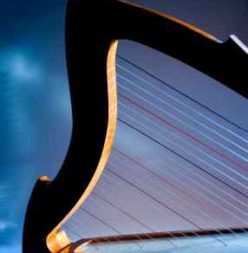Last month we improvised with some cool seventh chords, voiced “cluster” style (officially called closed position). For an even more lush, modern sound, let’s improvise with seventh chords in open voicing. We’ll use the same four chords: Cmaj7, Am7, Fmaj7, G7. Instead of playing the chord with four fingers in your left hand, we’re going to open them up and use three fingers of each hand.
In your left hand, play c, g and b (like the open voicing on a simple C chord, but with a b instead of the second c). In the right hand, play e b and e (the third, the seventh again, and another octave of the third). Between your hands, you’re now playing all the notes of a Cmaj7 chord, in an open (spread-out) voicing. You build the other chords the same way. Here they are spelled out for you:
| Finger | LH 4 |
2 | 1 | RH 4 |
2 | 1 |
| Cmaj7 | c | g | b | e | b | e |
| Am7 | a | e | g | c | g | c |
| Fmaj7 | f | c | e | a | e | a |
| G7 | g | d | f | b | f | b |
| chord degree | 1 | 5 | 7 | 3 | 7 | 3 |
Notice that there are always two empty strings between your two hands, and you’ll find the positions more easily. Once you understand the pattern, you can of course play any chords in the key with the voicing. But for now, try to play through the sequence above, rolling the chords in each hand as one unit or playing arpeggios, until you get very comfortable with the progression.
Once you know the progression inside and out, you’re ready to embellish it with improvisation. To start, try adding “filler” notes in the right hand, e.g. the notes between the upper tones of one chord and the next. For example, between Cmaj7 and Am7, you might walk between and around the notes e and c. Just relax, experiment and have fun!
This post is adapted from material that I originally published in the ezine, Notes from the Harp.
